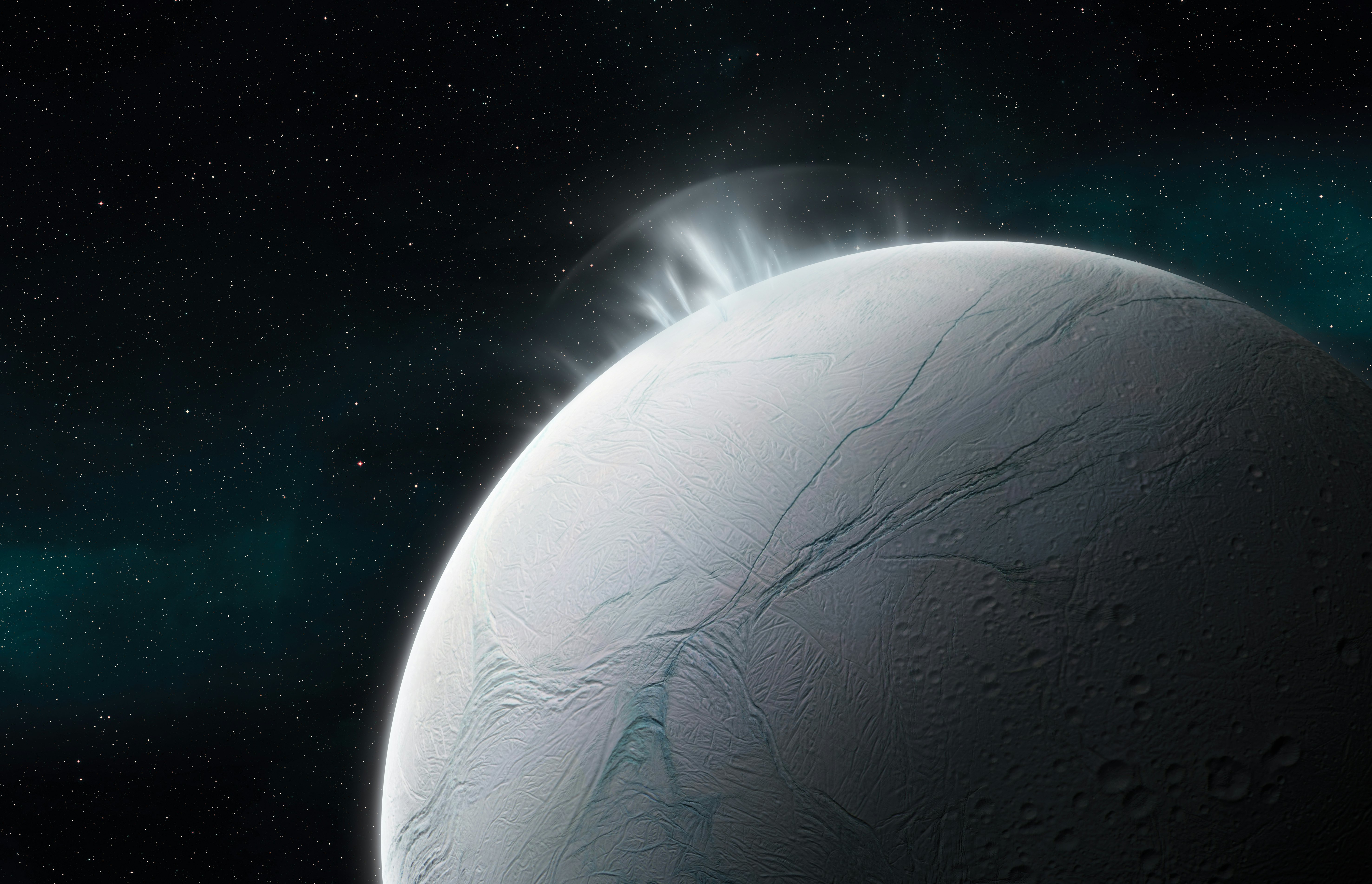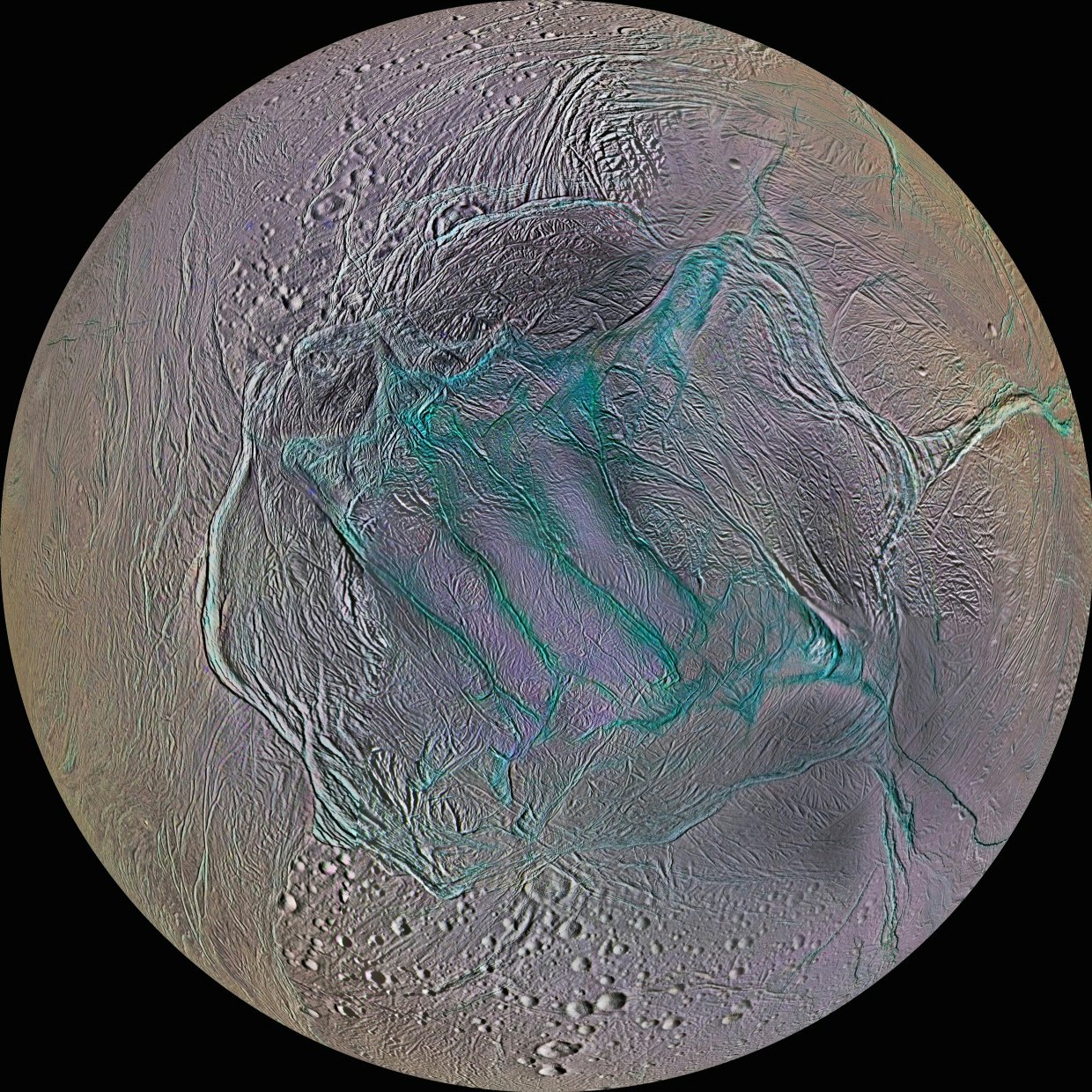
While on a world like Mars, we might have to dig underground to find life, or go miles under the ice on Jupiter’s moon Europa, one of the best targets for finding alien life could send life right up to a passing space probe. That’s according to a paper published last month in the Planetary Science Journal, which finds that the ice geysers on Saturn’s moon Enceladus may propel its potential lifeforms right out into space.
From its discovery in 1789 to the time the Voyager probes swung by Saturn in the early 1980s, Enceladus was just another outer-planet moon, glinting brightly from within Saturn’s wide E Ring. Voyager 2 saw that Enceladus was covered by fresh, new ice — geologically speaking, at least — as it zipped past, and astronomers began to suspect that the faint E Ring might have something to do with the tiny, icy moon at its center.
Enceladus became much more interesting in 2005, when the Cassini mission finally arrived after an eight-year voyage from Earth. Cassini found that Enceladus’ South Pole was covered in strange stripes, long ridges that are much younger and warmer than the rest of the moon’s surface.
These “tiger stripes” seem to have been the result of cryovolcanoes. As Saturn tugs on Enceladus, powerful tides pull the watery interiorup until huge plumes of water explode through the ice. And water isn’t the only thing Cassini found in these plumes: it also detected methane, which on Earth can be a sign of life or a sign of hydrothermal vents where life could thrive.
The team’s work focuses on modeling a hypothetical biosphere for Enceladus, given what Cassini was able to observe of the moon as it passed by. Starting from the assumption that life on Enceladus might be akin to relatively familiar — if still pretty extreme — methanogenic microorganisms that cluster around hydrothermal vents on Earth, they estimate that the tiny moon might be able to support an ecosystem that’s built around less than 10 tons of carbon, a total environment about as massive as one single whale.

Even though that’s not a lot of life, it’s still more than enough that it might be detectable without actually having to go down and look for it. Speaking with Inverse, lead author Antonin Affholder notes that applying ecosystem theory to a potentially habitable environment like Enceladus might allow future missions to go from looking for “very indirect biosignatures to slightly less indirect biosignatures.”
While there are ways that a lifeless system might be mistaken for one teeming with alien microbes or ways that one that’s actually full of life is mistaken for something lifeless, looking at the makeup and concentration of the other molecules in Enceladus’ cryovolcanic explosions offers a way to focus astrobiology’s search.
“In order to look for life, we need to build the tools to disprove its existence. We can only rely on indirect evidence and the best we can do to further the search for life is to fail to disprove its existence,” Paul Byrne, a planetary geologist at Washington University in St. Louis, tells Inverse, “it’s extremely difficult to be sure what we’re seeing is the result of biology and not some abiogenic process.”
This gets even trickier on Enceladus. The moon has been the target for many proposals since its 2005 highlights, and a future mission was named one of the top targets in the last U.S. Decadal Survey. But landing on Enceladus would risk contaminating an alien environment with life from Earth.
These concerns are why, in 2017, Cassini itself was sent plunging into Saturn rather than remaining in orbit: it’s possible some especially hardy microbe could have remained on the nuclear-warmed spacecraft over the course of its twenty-year mission, and scientists did not want to risk potential contamination. And beyond that, says Byrne, “even if you landed on Enceladus and got into the ocean, somehow melt your way down over the course of 10 years, unless something swims out of the dark and attacks you — which would be pretty compelling evidence of life there — just because you didn’t find the microbe doesn’t mean there isn’t life there.”
Even though an Enceladan biosphere would likely be tiny, the team’s model indicates that it would be big enough to be readily detected in orbit. Waste products — part of the system’s total biomass — along with living and dead cells would be ejected in the moon’s icy plumes, high enough that an orbiting mission would be able to collect them without having to make a landing.
The team estimates that you would need to collect a tenth of a milliliter–about a tenth of a raindrop–of material from the plume to have a good chance of determining whether or not there’s life there. That may not sound like much, but that still represents hundreds of flights through Enceladus’ eruptions.
“If you had the ability to see with a microscope something swimming around in a drop of water, that would be pretty compelling evidence of life — that’s probably not what it’s going to be,” says Byrne. If you fly through the plumes of Enceladus, you “have to time the speed of that flythrough just right — if you go too slow, you won’t catch much; if you go too fast, you could end up encountering a microbe but then blow it apart at the speed you’re hitting it.”
“There are a bunch of concepts for return to Enceladus, but it’s still an open field,” adds Affholder, “It’s very hard to say what will be the next mission to Enceladus.” More important for now, he says, is emphasizing that we can’t rule out life there: “In order to look for life, we need to build the tools to disprove its existence. We can only rely on indirect evidence and the best we can do to further the search for life is to fail to disprove its existence.”







